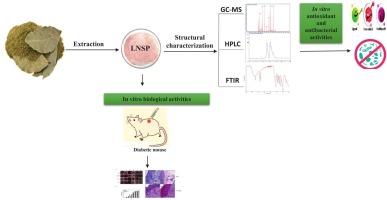Characterization of a green-synthesized heteropolysaccharide with promising diabetic wound healing potential
IF 4.2
Q2 CHEMISTRY, MULTIDISCIPLINARY
引用次数: 0
Abstract
Natural polysaccharides are increasingly explored for use in biomaterials, such as wound dressings, due to their excellent biocompatibility, low toxicity, and beneficial biomedical properties. This research investigates a natural polysaccharide hydrogel prepared using Laurus nobilis leaves (LNSP) and its in vivo potential to facilitate wound healing of a diabetic animal model. The results indicated a molecular weight of 105.37 kDa for the newly extracted polysaccharide. This heteropolysaccharide is composed of glucose (31.22 %), galactose (20.91 %), mannose (15.25 %), xylose (14.85 %), ribose (9.2 %), and rhamnose (8.57 %). Our findings showed that LNSP polysaccharide possesses antibacterial activity, acts as a potential antioxidant source, and exhibits no cytotoxic effects on human HEK-293 cells. In addition to displaying typical hydrogel characteristics, it also presents properties that promote wound re-epithelialization, replicate the structure of skin and stimulate skin regeneration in a diabetic rat model. Notably, it significantly improved the rate of wound contraction, reaching 100 % after 14 days. Histological assessment demonstrated that the LNSP hydrogel enhances re-epithelization and epidermal regeneration in diabetic rats compared to other treatment groups. This novel polysaccharide has been explored for dual applications: as a wound dressing and as a medium for direct drug delivery to the lesion site.

一种绿色合成的具有糖尿病伤口愈合潜力的杂多糖的特性
天然多糖由于其优良的生物相容性、低毒性和有益的生物医学特性,越来越多地被探索用于生物材料,如伤口敷料。本研究探讨了月桂叶制备的天然多糖水凝胶及其促进糖尿病动物模型创面愈合的体内潜力。结果表明,该多糖的分子量为105.37 kDa。这种杂多糖由葡萄糖(31.22%)、半乳糖(20.91%)、甘露糖(15.25%)、木糖(14.85%)、核糖(9.2%)和鼠李糖(8.57%)组成。我们的研究结果表明,LNSP多糖具有抗菌活性,是一种潜在的抗氧化来源,对人HEK-293细胞无细胞毒性作用。在糖尿病大鼠模型中,除了表现出典型的水凝胶特性外,还表现出促进创面再上皮化、复制皮肤结构和刺激皮肤再生的特性。值得注意的是,它显著提高了伤口收缩率,14天后达到100%。组织学评估表明,与其他治疗组相比,LNSP水凝胶增强了糖尿病大鼠的再上皮和表皮再生。这种新型多糖已被探索用于双重应用:作为伤口敷料和作为直接给药到病变部位的介质。
本文章由计算机程序翻译,如有差异,请以英文原文为准。
求助全文
约1分钟内获得全文
求助全文

 求助内容:
求助内容: 应助结果提醒方式:
应助结果提醒方式:


